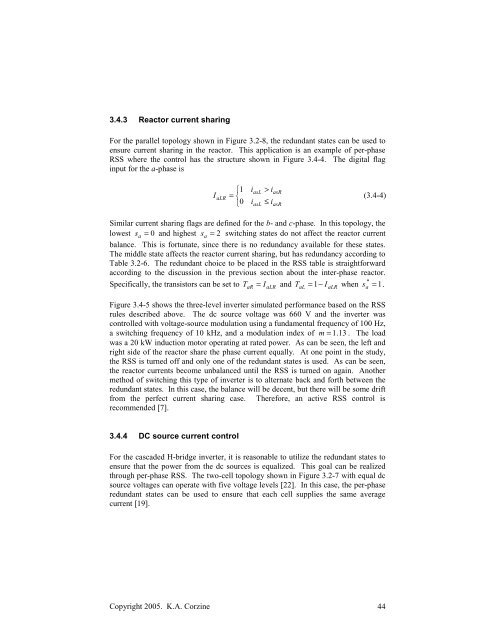Operation and Design of Multilevel Inverters Dr ... - MotorLab.com
Operation and Design of Multilevel Inverters Dr ... - MotorLab.com
Operation and Design of Multilevel Inverters Dr ... - MotorLab.com
You also want an ePaper? Increase the reach of your titles
YUMPU automatically turns print PDFs into web optimized ePapers that Google loves.
3.4.3 Reactor current sharing<br />
For the parallel topology shown in Figure 3.2-8, the redundant states can be used to<br />
ensure current sharing in the reactor. This application is an example <strong>of</strong> per-phase<br />
RSS where the control has the structure shown in Figure 3.4-4. The digital flag<br />
input for the a-phase is<br />
I<br />
aLR<br />
⎧1<br />
= ⎨<br />
⎩0<br />
Copyright 2005. K.A. Corzine 44<br />
i<br />
i<br />
asL<br />
asL<br />
> i<br />
≤ i<br />
asR<br />
asR<br />
(3.4-4)<br />
Similar current sharing flags are defined for the b- <strong>and</strong> c-phase. In this topology, the<br />
lowest s a = 0 <strong>and</strong> highest s a = 2 switching states do not affect the reactor current<br />
balance. This is fortunate, since there is no redundancy available for these states.<br />
The middle state affects the reactor current sharing, but has redundancy according to<br />
Table 3.2-6. The redundant choice to be placed in the RSS table is straightforward<br />
according to the discussion in the previous section about the inter-phase reactor.<br />
*<br />
Specifically, the transistors can be set to T aR = I aLR <strong>and</strong> TaL = 1 − I aLR when s a = 1.<br />
Figure 3.4-5 shows the three-level inverter simulated performance based on the RSS<br />
rules described above. The dc source voltage was 660 V <strong>and</strong> the inverter was<br />
controlled with voltage-source modulation using a fundamental frequency <strong>of</strong> 100 Hz,<br />
a switching frequency <strong>of</strong> 10 kHz, <strong>and</strong> a modulation index <strong>of</strong> m = 1.<br />
13 . The load<br />
was a 20 kW induction motor operating at rated power. As can be seen, the left <strong>and</strong><br />
right side <strong>of</strong> the reactor share the phase current equally. At one point in the study,<br />
the RSS is turned <strong>of</strong>f <strong>and</strong> only one <strong>of</strong> the redundant states is used. As can be seen,<br />
the reactor currents be<strong>com</strong>e unbalanced until the RSS is turned on again. Another<br />
method <strong>of</strong> switching this type <strong>of</strong> inverter is to alternate back <strong>and</strong> forth between the<br />
redundant states. In this case, the balance will be decent, but there will be some drift<br />
from the perfect current sharing case. Therefore, an active RSS control is<br />
re<strong>com</strong>mended [7].<br />
3.4.4 DC source current control<br />
For the cascaded H-bridge inverter, it is reasonable to utilize the redundant states to<br />
ensure that the power from the dc sources is equalized. This goal can be realized<br />
through per-phase RSS. The two-cell topology shown in Figure 3.2-7 with equal dc<br />
source voltages can operate with five voltage levels [22]. In this case, the per-phase<br />
redundant states can be used to ensure that each cell supplies the same average<br />
current [19].


